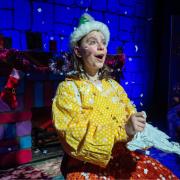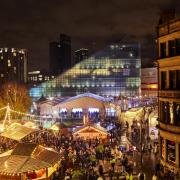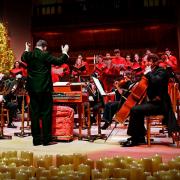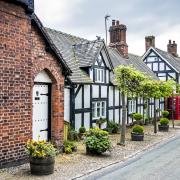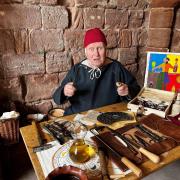Every so often, a country walk poses a puzzle. It struck me as I took a breather in the peaceful surrounds of St Michael’s Church in the rural parish of Baddiley: just why is there a church here, at the end of a no-through road in the middle of nowhere? The diminutive church looks Georgian at first glance. The only dwellings nearby are a farm, a couple of cottages and the adjacent Baddiley Hall, which dates from the late 17th century. Although the hall is a substantial pile, it’s surely not grand enough for the lord of the manor to have afforded a private chapel? Even allowing for greater religious observance in days gone by, the settlement just doesn’t seem big enough to support a new church, however small. So, what’s going on?
The solution to the puzzle is twofold. The first part is revealed by strolling to the far end of the church (or taking a look inside, if it’s open). The tell-tale half-timbering of the chancel and the venerable cruck arch framing the east window reveal that the church is much older than it first looks. In fact, this part of the church dates from the early 1300s and represents one of very few remaining timber-framed medieval churches in the country, let alone the county.

Deserted medieval villages (DMVs in archaeological parlance) are rare in Cheshire and the north-west; they’re more associated with the Midlands and north-east of England. Rural depopulations are often casually ascribed to the Black Death, but in truth many extinct villages noted in Domesday were already in decline by the 14th century or were abandoned later. Pandemics obviously had a huge impact in the days before vaccinations and modern treatments, but the true causes of lost villages are complex and various. A village might be razed or relocated to improve the view from an aristocrat’s family seat. In coastal or riverside areas, floods, erosion or silting could remove the livelihood of the villagers. Elsewhere, shifts in economic circumstances or agricultural practice, such as the wider move from arable strip-farming to sheep, are often implicated, and that seems the most plausible cause here.
The site of Baddiley village is a Scheduled Monument, and the schedule paints a rather idyllic picture of the medieval settlement as a cluster of cottages and barns running down the valley of a small stream (now culverted), below the timber church and a moated manor house on the site of the present Baddiley Hall. The village may have been more extensive than the surviving earthworks imply, but outside the scheduled area the remnants have been erased by later ploughing and by the cutting of the Llangollen Canal in 1805 – which took place not long before the little wooden medieval church was encased in brick.
As well as for Sunday services, the church is typically open on Tuesdays and Thursdays, thanks to the good offices of the keyholders (whose phone numbers are listed on a notice in the church porch). If you trouble them for a key or you’re lucky enough to find the building open, inside you’ll see an eye-catching and rare pre-Reformation screen bearing the arms of Charles II, box pews, a west gallery, a triple-decker pulpit and, of course, the timber-framed chancel of the original church that solves our little mystery.
1. From the car park of the Farmers Arms, cross carefully and walk down Swanley Lane opposite. Just beyond the telephone kiosk, turn left into Chapel Lane. Continue past the end of Baddiley Close (left) and cross a perpendicular footpath. At the end of the lane, continue along the gravel driveway of The Beeches. Just before the gates to the property, turn right over a wooden stile.
2. A permitted path heads half-left, diagonally across the field. As you cross, you may notice a stile in the left-hand hedge – disregard it (this is our return route). In the far left-hand corner of the field, cross a second stile. Turn left along the narrow, hedged field-cum-green-lane to a field gate at the far end. Cross a further field to reach a kissing gate which gives onto the canal towpath next to bridge 12.
3. Turn left beneath the arch and follow the towpath to the next bridge (bridge 13). Beyond this bridge, looking right over the canal, are glimpses of Baddiley Hall and the deserted village, but you will have closer views later. Continuing along the canal you pass two locks and some houses on the left before arriving at bridge 14.



6. Cross the bridge (with stiles on both sides) then bear half-right across the next field to pass to the right of a slurry pond. Climb a stile next to a field gate and walk along the left-hand hedge to another stile. In the next field, aim left of the thatched cottage and its garden to find a kissing gate in the hedge. Bear right across the field towards a footpath sign, where you rejoin the driveway to The Beeches.
7. Turn left and retrace your steps along Chapel Lane and, back at the village green, turn right to the Farmers Arms.
COMPASS POINTS
Area of walk: Ravensmoor, near Nantwich
Start point: Farmers Arms (parking for patrons only)
Distance: 3¾ miles/6.1 km
Time to allow: 2 hours
Map: OS Explorer 257: Crewe and Nantwich
Refreshments: Farmers Arms facebook.com/farmersarmsravensmoor
Practicalities: Several stiles and some road walking. Buses 70 and 71 serve Ravensmoor from Nantwich.

The Farmers Arms
The Farmers Arms in Ravensmoor is a proper village pub. Housed in a long, creeper-covered building of indeterminate age, it overlooks the Cheshire-fenced green at the centre of the village. The right-hand end nearest the car park houses the restaurant, but turn left from the front door and you’ll find yourself in an old-school saloon bar, complete with dartboard, pool table and a congregation of locals. Dogs are welcome in this bar and in the garden, but not in the restaurant.
The menu is similarly traditional but with plenty of nods towards modernity. Alongside the steak-and-ale pies, beef lasagnas and fish and chips you’ll find gluten-free, vegetarian and vegan options. The main courses on the lunchtime menu are affordably priced at £8.95, or there’s a soup and a sandwich deal for £9.95 and a range of bar snacks. Friday night is burger night. If you’re visiting in the first few days of September, though, bring a picnic as the kitchen will be closed while the chef takes a break. Normally, food is served at lunchtime for a couple of hours from noon, and from 5pm to 8pm, except on Mondays and Tuesdays (when the pub is only open for drinks, and only from 4pm), and on Sundays (from noon till 6pm).
The regular hand-pulled cask ale is the pale, hoppy White Rat from the Ossett Brewery and there is a regularly changing guest beer on the second pump.
The sizeable car park is for patrons only, but there are three or four public spaces opposite, next to the phone box (now repurposed to house a defibrillator) overlooking the village green.






